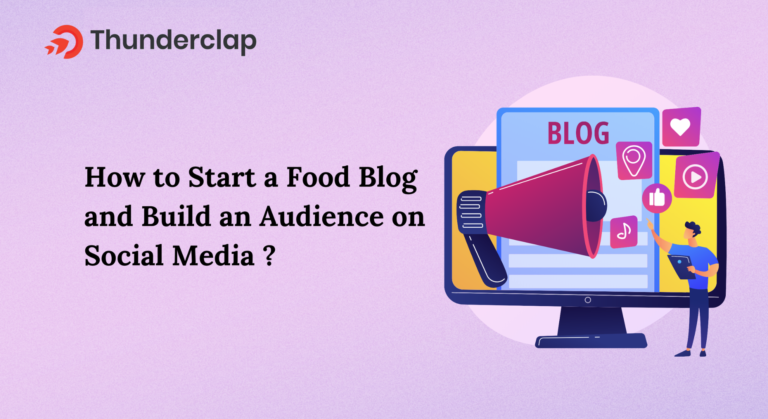Love and Lemons, Cookie and Kate, Pinch of Yum, Smitten Kitchen, Budget Bytes – you might have thought we have mentioned the names of exotic dishes. However, these are the top 5 food blogs in the world.
Starting a food blog is a thrilling journey where you can share your culinary knowledge with a broad audience. Furthermore, social media can help you increase your blog’s ranking and traffic to share your tasty recipes.
You can also explore social media growth services to increase engagement on your food blog. These services can help attract a targeted audience and boost your online presence.
This guide will help you begin your food blogging journey and build a robust social media presence.
5 Steps to Begin Your Food Blogging Adventure
Your food blog’s success depends on effectively leveraging social media platforms and their features. This guide will walk you through the important steps to selecting the best platforms, creating engaging content, and growing your audience.
Step 1: Choose the Right Social Media Platforms
Selecting the appropriate social media platforms for your content and audience is essential to expanding your reach. Various platforms provide specific benefits for bloggers who focus on food.
Use a combination of Instagram Stories and Reels to show cooking tips to people. Additionally, Interact with your viewers via comments and private messages to establish a sense of community.
Add hashtags and geotags to boost visibility. Furthermore, you can partner with fellow food influencers to broaden your audience.
Optimize your pins with keywords to enhance their searchability. Additionally, join group boards to increase the visibility of your content and collaborate with fellow food bloggers.
Moreover, continuously post fresh and important content to maintain the audience’s interest. You can also use Pinterest’s lasting traffic possibilities for this purpose.
Set up a specialized webpage for your blog. On that page, you can post frequent updates, recipes, and cooking videos on Facebook.
Furthermore, respond to comments and messages to interact with your audience. Additionally, use Facebook Ads to reach specific demographics and increase your audience reach.
You can also engage in food-centered communities to interact with individuals with similar interests and exchange your content.
- YouTube
Emphasize producing high-quality items and providing clear directions on YouTube. Moreover, improve your video titles and descriptions by including appropriate keywords.
Additionally, interact with your audience by responding to comments and prompting them to subscribe to your channel. Lastly, make playlists to arrange your content and help viewers quickly locate particular recipes.
Step 2: Create Engaging Social Media Content
Developing engaging material that connects with your audience is crucial for establishing a dedicated fan base. Make sure that your content is visually attractive, educational, and engaging.
- High-Quality Photos and Videos
Get a high-quality camera and lighting arrangement to take amazing pictures and videos of your food.
Next, revise your material to improve its attractiveness and maintain a cohesive style representing your brand.
Furthermore, utilize various perspectives and zoom in on specific elements to highlight the intricate features of your food, making it impossible for your viewers to resist.
- Interactive Content
Engagement can be increased by incorporating interactive content such as polls, quizzes, and Q&A sessions.
For instance, Instagram Stories and Facebook Live can be utilized for live cooking demonstrations. You can also respond to follower inquiries. Overall, this engagement enhances the bond with your audience.
- User-Generated Content
Motivate your audience to make and post their own interpretations of your dishes. Additionally, share their posts on your social media accounts, acknowledging their authorship.
Moreover, develop a unique hashtag for your followers to include in their posts of their recreations, and showcase the top ones on your profile to recognize your audience’s hard work.
Step 3: Strategize for Increasing Followers
Increasing the number of your followers necessitates careful planning and ongoing dedication. Utilizing successful tactics can aid in attracting and retaining a more significant number of followers.
- Collaborations and Influencer Marketing
Join hands with other food bloggers and influencers to reach their audience. You can work with them on new projects, invite them to share their favorite food recipe with your audience, write social media content for each other’s platforms, or participate in social media collaborations.
By doing so, food influencers can bring your blog to the attention of their followers, increasing both traffic and engagement.
- Consistent Posting Schedule
Consistency is crucial in retaining and expanding your viewership. Therefore, create a schedule for posting content and consistently follow it. This ensures that your audience stays interested and returns for additional content.
Additionally, utilize scheduling software to organize and automate your posts, guaranteeing a consistent content stream even when busy.
- Utilize Hashtags
Utilize appropriate hashtags in your posts to boost their visibility. Moreover, develop a unique hashtag for your blog to inspire user-created content.
Keep an eye on popular hashtags in the food blogging world and include them in your posts to expand your reach.
Step 4: Engage with Your Audience
Creating a devoted fan base entails consistently interacting with your viewers. In fact, engaging with your followers consistently builds a feeling of unity.
- Respond to Comments and Messages
Respond quickly to comments and messages to attract the attention of your audience. Additionally, this activity will convey to them that you appreciate their feedback.
Furthermore, customize your replies to show appreciation to your followers and prompt more engagement.
- Host Challenges and Events
Organizing cooking competitions and activities can increase people’s involvement in your blog. Motivate followers to engage and showcase their own creations.
In addition, promote their submissions on your social media profiles to encourage a feeling of togetherness.
Lastly, you can provide rewards like gifts or acknowledgments to encourage engagement and enhance the activities’ attractiveness.
Step 5: Leverage Social Media Analytics
Utilizing analytical tools can help you comprehend your audience and improve your tactics. Furthermore, consistently reviewing your performance data is crucial for ongoing enhancement.
- Track Engagement Metrics
To evaluate your content’s performance, keep track of the number of likes, shares, comments, and saves it receives.
Then, utilize this information to determine what connects with your viewers and customize future content accordingly.
Additionally, be mindful of the kinds of posts that receive the highest engagement and attempt to duplicate their achievements.
- Adjust Strategies Based on Data
Frequently monitor your analytics data to modify your social media strategies. For instance, try out various types of content and posting times to determine the most effective strategies.
Finally, remain adaptable and open to adjusting your tactics as you gain further insights into your audience’s preferences.
Conclusion: Start Your Food Blog Now!
Starting a food blog demands extensive hard work, and promoting it on social media adds an extra layer.
Select a perfect social media platform, work on your content, post it, and interact with your audience. Follow the strategies and build your audience seamlessly!

